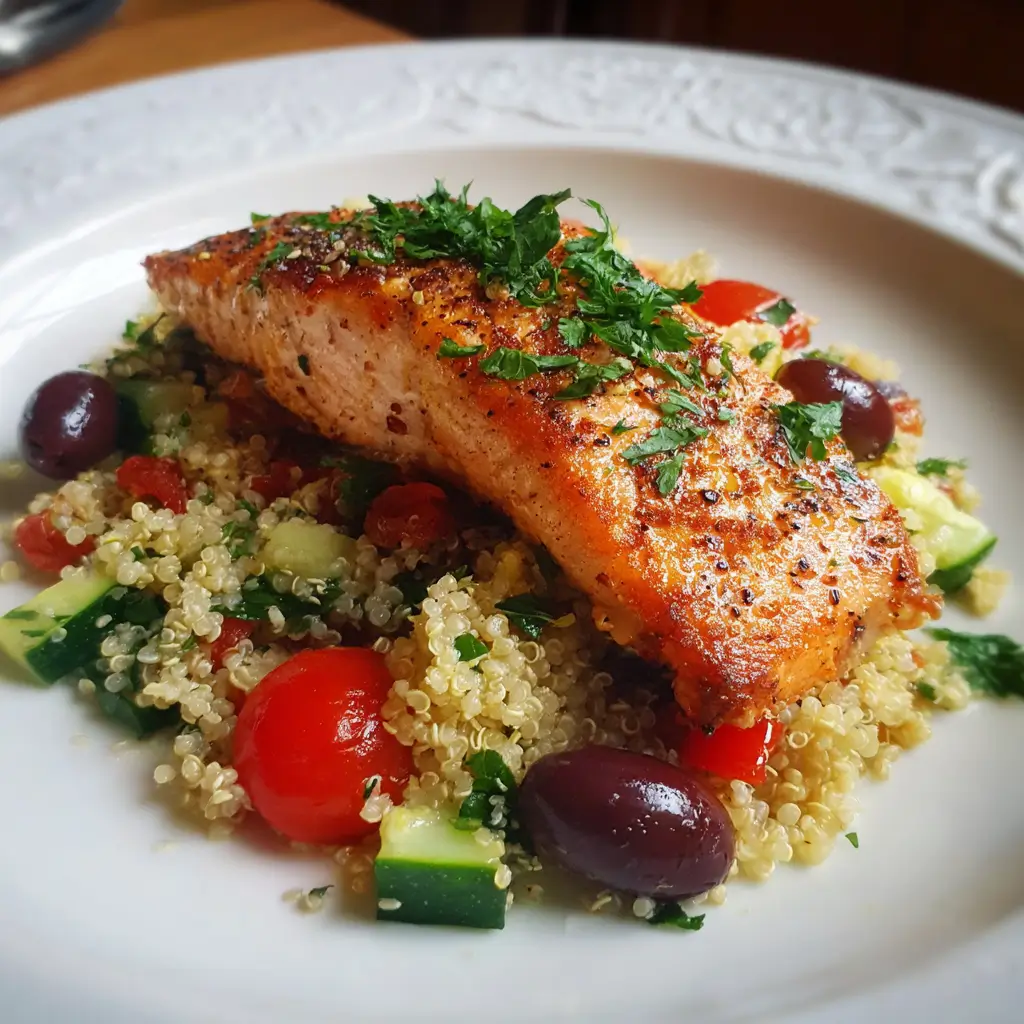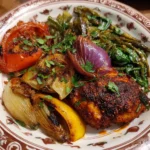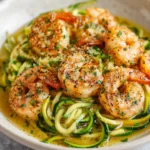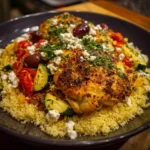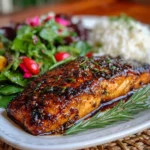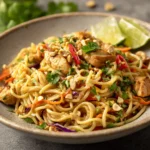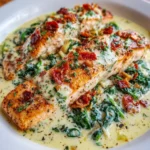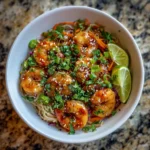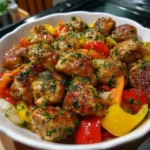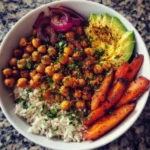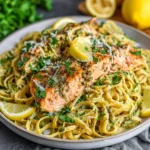Mediterranean Salmon with Quinoa: A Flavorful Journey to the Sun-Kissed Shores of the Mediterranean
Imagine a dish that combines the rich, buttery flavor of wild-caught salmon with fluffy, protein-packed quinoa, all kissed by the sun-drenched herbs, citrus, and olive oil of the Mediterranean coast. Mediterranean Salmon with Quinoa is not just a meal—it’s an experience. This vibrant, nutrient-dense recipe brings together bold flavors and wholesome ingredients to create a balanced plate that satisfies both your palate and your well-being. Whether you’re cooking for yourself on a busy weeknight or impressing guests at a weekend dinner, this dish delivers elegance without complexity, health without compromise, and taste without boundaries.
The History of Mediterranean Cuisine and Its Influence on This Dish
The Mediterranean region—encompassing countries like Greece, Italy, Spain, Turkey, and southern France—has long been celebrated for its culinary traditions rooted in simplicity, seasonality, and balance. The Mediterranean diet, recognized by UNESCO as an Intangible Cultural Heritage, emphasizes fresh vegetables, whole grains, legumes, olive oil, fish, and moderate dairy and wine consumption. This way of eating has been linked to longevity, heart health, and reduced risk of chronic diseases.
Salmon, though not native to the Mediterranean Sea, has become a staple in modern Mediterranean-inspired dishes due to its high omega-3 content and luxurious texture. When paired with quinoa—an ancient Andean grain now beloved worldwide for its complete protein profile—the dish becomes a fusion of global wellness cuisine. Over time, chefs and home cooks alike have adapted traditional Mediterranean flavors to include ingredients like lemon, garlic, oregano, olives, and tomatoes, creating harmonious recipes such as this one that celebrate cross-cultural nutrition and flavor.
Ingredients Breakdown: Why Each Component Matters
- Salmon Fillets (6 oz each): Rich in omega-3 fatty acids (EPA and DHA), high-quality protein, vitamin D, and selenium, salmon supports brain health, reduces inflammation, and promotes cardiovascular wellness. Opt for wild-caught over farmed when possible to minimize environmental impact and maximize nutritional benefits.
- Quinoa: A gluten-free pseudo-grain, quinoa contains all nine essential amino acids, making it a rare complete plant-based protein. It’s also high in fiber, magnesium, iron, and antioxidants, contributing to stable blood sugar levels and digestive health.
- Olive Oil (Extra Virgin): The cornerstone of Mediterranean cooking, EVOO is rich in monounsaturated fats and polyphenols, which help reduce bad cholesterol and protect against oxidative stress.
- Lemon Juice and Zest: Adds bright acidity while boosting vitamin C content. Lemon zest intensifies flavor and contains limonene, a compound studied for potential anti-cancer properties.
- Garlic: Known for its immune-boosting and antimicrobial properties, thanks to allicin, garlic enhances savory depth and adds medicinal value.
- Dried Oregano and Thyme: These aromatic herbs aren’t just flavorful—they’re packed with antioxidants and have anti-inflammatory effects. Oregano, in particular, has shown strong antimicrobial activity in studies.
- Cherry Tomatoes: Bursting with lycopene, a powerful antioxidant associated with reduced risk of prostate cancer and heart disease, these sweet morsels add color and juiciness.
- Kalamata Olives: Briny and rich, they contribute healthy fats and a distinctive Mediterranean flair. They’re also a source of iron and vitamin E.
- Red Onion: Provides crunch and sharpness, along with quercetin, a flavonoid known for its anti-allergic and anti-inflammatory properties.
- Fresh Parsley: More than just garnish, parsley is rich in vitamins K, A, and C, and contains apigenin, a compound being researched for neuroprotective benefits.
- Salt and Black Pepper: Used mindfully, they enhance flavor and support electrolyte balance and digestion.
- Pinch of Red Pepper Flakes (optional): Adds heat and capsaicin, which may boost metabolism and provide pain relief through endorphin release.
Step-by-Step Recipe: How to Make Mediterranean Salmon with Quinoa
- Prepare the Quinoa: Rinse 1 cup of quinoa under cold water using a fine-mesh strainer to remove saponins, which can make it taste bitter. In a medium saucepan, combine the rinsed quinoa with 2 cups of water or low-sodium vegetable broth for added flavor. Bring to a boil, then reduce heat to low, cover, and simmer for 15 minutes or until the liquid is absorbed and the quinoa is fluffy with a slight curl visible in the grains. Remove from heat, fluff with a fork, and let it sit covered for 5 minutes. Stir in a drizzle of olive oil and set aside.
- Season the Salmon: Pat 4 salmon fillets dry with paper towels to ensure proper searing. Place them on a plate and season both sides generously with salt, freshly ground black pepper, 1 teaspoon dried oregano, ½ teaspoon garlic powder, and the zest of one lemon. Let them rest at room temperature for 10–15 minutes to allow the flavors to penetrate and promote even cooking.
- Preheat and Sear (Optional): While baking is gentler, searing gives a restaurant-quality crust. Heat 1 tablespoon of olive oil in an oven-safe skillet over medium-high heat. Once shimmering, place the salmon skin-side down (if skin-on) and sear for 3–4 minutes until golden brown. Flip carefully and transfer the skillet to a preheated oven at 375°F (190°C) for 8–10 minutes, depending on thickness, until the internal temperature reaches 125–130°F (medium-rare) or up to 145°F (well-done) per FDA guidelines.
- Roast the Vegetables (Simultaneously): On a large baking sheet, toss halved cherry tomatoes, sliced red onion, and pitted Kalamata olives with 2 tablespoons of olive oil, juice of half a lemon, 1 minced garlic clove, ½ teaspoon dried thyme, salt, pepper, and optional red pepper flakes. Spread evenly and roast in the same oven at 375°F for 20–25 minutes, stirring once halfway through, until tomatoes are blistered and onions are tender.
- Rest the Salmon: Once cooked, remove salmon from the oven and let it rest for 5 minutes. This allows juices to redistribute, ensuring moist, flaky flesh.
- Assemble the Bowls: Divide the cooked quinoa among four serving plates or shallow bowls. Top each with a salmon fillet. Spoon the roasted Mediterranean vegetables and olives around the salmon. Drizzle everything with any pan juices or an additional tablespoon of extra virgin olive oil for richness.
- Garnish and Serve: Finish each bowl with a generous sprinkle of chopped fresh parsley, an extra squeeze of lemon juice, and perhaps a few more cracked peppercorns. For visual appeal and freshness, consider adding a few mint leaves or microgreens.
Expert Tips for Perfect Mediterranean Salmon with Quinoa Every Time
- Choose High-Quality Salmon: Look for firm, bright-orange flesh with no fishy odor. Wild Alaskan sockeye or coho are excellent sustainable choices.
- Don’t Skip the Rest: Allowing salmon to rest after cooking prevents moisture loss when cutting or flaking.
- Toast the Quinoa (Optional): For a nuttier flavor, toast the rinsed quinoa in a dry saucepan for 3–4 minutes before adding liquid.
- Use a Meat Thermometer: To avoid overcooking, insert a thermometer into the thickest part of the salmon. Aim for 125°F if you prefer medium-rare (it will rise 5–10 degrees during resting).
- Batch Cooking Friendly: Double the quinoa and roasted veggies; store separately in airtight containers for up to 4 days. Reheat gently and pair with freshly cooked salmon for quick lunches.
- Prevent Sticking: If baking instead of searing, line your pan with parchment paper or lightly grease it to prevent sticking, especially if your salmon is skinless.
- Balance Acidity: Taste the tomato mixture before roasting—if too tart, add a pinch of honey or maple syrup to balance the lemon.
Variations and Customizations: Make It Your Own
This recipe is incredibly adaptable based on dietary needs, preferences, or what you have in your pantry:
- Vegetarian/Vegan Option: Replace salmon with grilled halloumi, marinated tofu, tempeh, or chickpeas tossed in the same seasoning blend and roasted alongside the vegetables.
- Gluten-Free Friendly: Naturally gluten-free, but always check labels on broths or spice blends if using store-bought versions.
- Low-Carb/Keto Version: Swap quinoa for cauliflower rice sautéed in olive oil with garlic and herbs. Increase healthy fat content with avocado slices or extra olives.
- Add Greens: Stir baby spinach or arugula into warm quinoa until wilted, or serve the dish over a bed of mixed greens for a salad-style presentation.
- Grain Alternatives: Try farro, bulgur, brown rice, or freekeh instead of quinoa for different textures and flavors.
- Seafood Swaps: Use sea bass, cod, trout, or swordfish in place of salmon. Adjust cooking times accordingly.
- Citrus Variations: Substitute lemon with orange, lime, or blood orange for a unique twist. Orange pairs beautifully with fennel if added to the veggie mix.
- Mediterranean Mezze Style: Serve components family-style on a large platter with hummus, tzatziki, pita bread, and dolmas for a festive spread.
- Spice It Up: Add harissa paste, smoked paprika, or za’atar seasoning to the salmon rub for Middle Eastern flair.
- Creamy Element: Drizzle with tahini-lemon sauce, skyr yogurt, or labneh for added creaminess and tang.
Health Considerations and Nutritional Value
Mediterranean Salmon with Quinoa is a powerhouse of balanced nutrition, aligning closely with the principles of the evidence-based Mediterranean diet, which has been consistently ranked among the healthiest diets by U.S. News & World Report.
Nutritional Profile (Per Serving – Approximate)
| Nutrient | Amount |
|---|---|
| Calories | 520 kcal |
| Protein | 34g |
| Total Fat | 28g |
| Saturated Fat | 5g |
| Monounsaturated Fat | 16g |
| Polyunsaturated Fat (incl. Omega-3s) | 6g |
| Carbohydrates | 32g |
| Dietary Fiber | 5g |
| Sugars | 6g (natural) |
| Sodium | 480mg (varies with added salt) |
| Vitamin D | 50% DV |
| Vitamin C | 40% DV |
| Iron | 20% DV |
| Magnesium | 25% DV |
| Selenium | 110% DV |
Key Health Benefits:
- Heart Health: Omega-3s in salmon lower triglycerides and reduce arterial inflammation. Olive oil improves HDL (“good”) cholesterol.
- Brain Function: DHA supports cognitive function and may reduce the risk of neurodegenerative diseases like Alzheimer’s.
- Blood Sugar Regulation: Quinoa has a low glycemic index, preventing spikes in insulin. Fiber slows glucose absorption.
- Weight Management: High protein and fiber content promote satiety, helping control appetite and reduce snacking.
- Antioxidant Protection: Lycopene (tomatoes), oleocanthal (olive oil), and flavonoids (herbs) combat oxidative damage linked to aging and cancer.
- Bone and Immune Support: Vitamin D and selenium strengthen immunity and bone density.
Considerations:
- Pregnancy/Nursing: Salmon is safe and recommended (2–3 servings/week) due to DHA content crucial for fetal brain development. Avoid raw versions unless using sushi-grade fish.
- Gout: Moderate intake advised due to purine content in salmon; consult with a healthcare provider.
- Sodium Sensitivity: Reduce added salt and choose low-sodium olives or omit them if necessary.
- Allergies: Shellfish allergies do not affect salmon, but ensure no cross-contamination if preparing multiple seafood items.
Complete Ingredients List
- 4 (6 oz) salmon fillets, skin-on or skinless
- 1 cup uncooked quinoa (white, red, or tri-color)
- 2 cups water or low-sodium vegetable broth
- 3 tbsp extra virgin olive oil (divided)
- Juice and zest of 1 large lemon
- 2 cloves garlic, minced
- 1 tsp dried oregano
- ½ tsp dried thyme
- ½ tsp salt (or to taste)
- Freshly ground black pepper to taste
- 1 pint cherry tomatoes, halved
- ½ red onion, thinly sliced
- ½ cup pitted Kalamata olives, halved
- ¼ tsp red pepper flakes (optional)
- ¼ cup fresh parsley, finely chopped
- Lemon wedges, for serving
Detailed Directions
- Cook the Quinoa: Rinse quinoa thoroughly under cold running water. In a medium pot, bring 2 cups of water or broth to a boil. Add quinoa, return to a boil, then reduce heat to low. Cover and simmer for 15 minutes. Turn off heat and let stand, covered, for 5 minutes. Fluff with a fork and stir in 1 teaspoon of olive oil. Set aside.
- Marinate the Salmon: In a small bowl, mix lemon zest, 1 teaspoon olive oil, ½ teaspoon oregano, garlic powder, salt, and pepper. Rub this mixture evenly over both sides of the salmon fillets. Let sit for 10–15 minutes.
- Preheat Oven: Set oven to 375°F (190°C). Line a baking sheet with parchment paper or lightly oil a skillet.
- Prepare the Vegetable Mix: In a large bowl, combine cherry tomatoes, red onion, olives, minced garlic, lemon juice, 2 tablespoons olive oil, thyme, remaining oregano, salt, pepper, and red pepper flakes. Toss well to coat.
- Arrange for Roasting: Spread the vegetable mixture in a single layer on the prepared baking sheet. Place seasoned salmon fillets on top or beside the veggies, ensuring space between each piece.
- Bake: Roast in the preheated oven for 15 minutes. Gently flip the vegetables, then continue baking for another 10–15 minutes, or until salmon flakes easily with a fork and reaches desired doneness.
- Final Touches: Remove from oven. Let salmon rest 5 minutes. Taste the vegetables and adjust seasoning if needed.
- Serve: Spoon quinoa into bowls. Top with salmon and spoon roasted vegetables and juices over the top. Garnish with fresh parsley and lemon wedges. Serve immediately.
Frequently Asked Questions (FAQ)
Q: Can I use frozen salmon?
A: Yes, but thaw it slowly in the refrigerator overnight for best texture. Never cook frozen salmon directly unless specified in a recipe, as it may result in uneven cooking.
Q: Is quinoa better than rice?
A: Quinoa has more protein, fiber, and essential amino acids than white rice. However, brown rice is also nutritious. Choose based on dietary goals—quinoa for protein, rice for lower cost or preference.
Q: Can I prepare this ahead of time?
A: Absolutely! Cook quinoa and roast veggies up to 3 days in advance. Store separately in the fridge. Cook salmon fresh for optimal texture, but you can marinate it the night before.
Q: What side dishes go well with this?
A: Try a simple cucumber-tomato salad, grilled asparagus, roasted zucchini, or a dolma platter. A glass of crisp white wine like Sauvignon Blanc complements the citrus notes.
Q: How do I know when salmon is done?
A: It should flake easily with a fork and appear opaque throughout. Internal temperature should be 145°F at the thickest part, though many chefs prefer 125–130°F for moist results.
Q: Can I grill this instead?
A: Definitely! Grill salmon over medium heat (about 4–5 minutes per side) and roast veggies separately. Use a grill basket for smaller pieces.
Q: Are Kalamata olives necessary?
A: They add authenticity, but you can substitute Niçoise, Castelvetrano, or even tapenade for variety.
Q: Is this kid-friendly?
A: Many children enjoy the mild flavor of salmon when seasoned well. Serve with a side of fruit or sweet potato fries to balance the meal.
Summary
Mediterranean Salmon with Quinoa is a nourishing, flavor-packed dish that embodies the essence of healthy, joyful eating—rich in omega-3s, plant-based proteins, antioxidants, and heart-healthy fats. With its vibrant colors, bold tastes, and endless customization options, it’s perfect for anyone seeking a delicious step toward better well-being.
